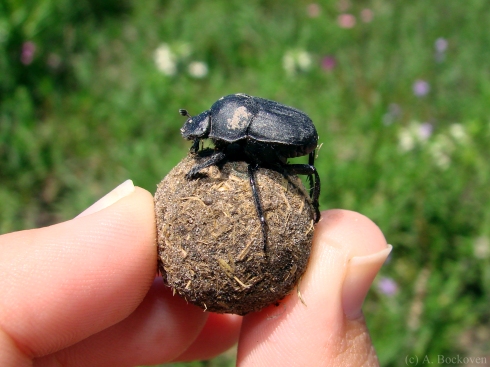Here’s a beetle that my dog, a budding canine entomologist, chased down and caught for me on our walk the other day. These big, metallic green beetles are one of the more striking insects we see in the area. This fellow was out a bit late in the year, so it was fun to see one.
 Much like the brown june beetles (or “junebugs”) that mob my porch in the summer, adult green june beetles are attracted to lights. The adults feed on fruit and sometimes flowers (they are a significant vineyard pest), while the grubs shelter in the soil during the day and emerge at night to feed on vegetation and roots (they can be a minor lawn pest). Apparently these grubs have the unique habit of crawling on their backs, using short stiff hairs rather than their legs, which is a cool fact I did not know. Two characters of note for this genus are the horn-like projection of the mouthparts and the way in which the pronotum (first plate of the back) extends to a point, covering the scutellum.
Much like the brown june beetles (or “junebugs”) that mob my porch in the summer, adult green june beetles are attracted to lights. The adults feed on fruit and sometimes flowers (they are a significant vineyard pest), while the grubs shelter in the soil during the day and emerge at night to feed on vegetation and roots (they can be a minor lawn pest). Apparently these grubs have the unique habit of crawling on their backs, using short stiff hairs rather than their legs, which is a cool fact I did not know. Two characters of note for this genus are the horn-like projection of the mouthparts and the way in which the pronotum (first plate of the back) extends to a point, covering the scutellum.
As a side note, it is extremely difficult to capture metallic and iridescent coloration on camera (I lack the appropriate combination of equipment, patience, and skill). Ted MacRae of Beetles in the Bush has some good comments on the subject, and just generally takes gorgeous tiger beetle photos.














Recent Comments